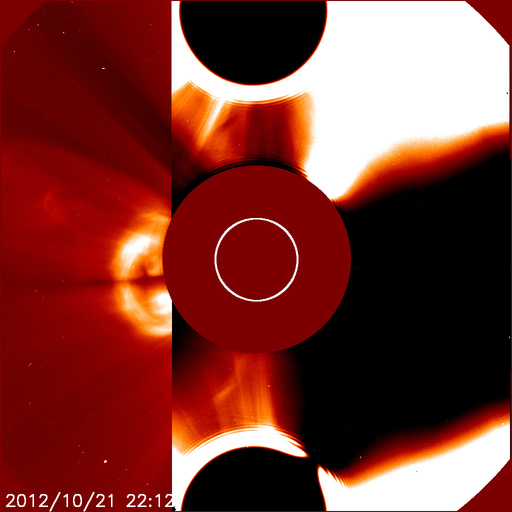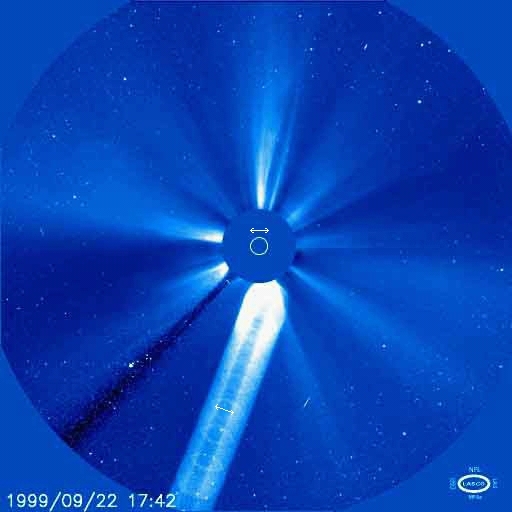It looks like you're using an Ad Blocker.
Please white-list or disable AboveTopSecret.com in your ad-blocking tool.
Thank you.
Some features of ATS will be disabled while you continue to use an ad-blocker.
4
share:
When entering this information on the Solar Heliospheric Observatory below

In movie mode

This was observed.

Just wondering if any can explain what can cause this glitch in the movie and SOHO images?
sohodata.nascom.nasa.gov...
Thanks in advance

In movie mode

This was observed.

Just wondering if any can explain what can cause this glitch in the movie and SOHO images?
sohodata.nascom.nasa.gov...
Thanks in advance
edit on 9/9/13 by ophiuchus 13 because: (no reason given)
The sun releases high energy particles that often affect the camera and sensors sometimes so severe (during a CME or a X-ray flare) it causes a
particle storm
They show up as extra little dots across the field of view and do not last long typically into subsequent images.
They show up as extra little dots across the field of view and do not last long typically into subsequent images.
edit on 9-9-2013 by abeverage
because: (no reason given)
I Think the lens might have received some damage. If you keep seeing the soho videos, you can still see stars passing through the "anomaly", so it
is like a watermark on the lens caused by some exterior damage.
bugs birds dust weather balloons chinese laterns ...
sorry had to do to that
interesting tho.. hope ya get an answer.
sorry had to do to that
interesting tho.. hope ya get an answer.
reply to post by abeverage
reply to post by hades84
Both sound like plausible suggestions 1 appreciates your support
NAMASTE*******
reply to post by thishereguy
Interesting
reply to post by whatnext21
Thanks for the link whatnext21, shall take a look...
reply to post by hades84
Both sound like plausible suggestions 1 appreciates your support
NAMASTE*******
reply to post by thishereguy
Interesting
reply to post by whatnext21
Thanks for the link whatnext21, shall take a look...
edit on 9/9/13 by ophiuchus 13 because: (no reason given)
whatnext21
Suspicious Observer explained this in the video uploaded for September 9th this morning.
AH! I didn't see the burn in shadow image and assumed the OP meant the particle images.
This is the correct answer.
Ever stare a bright light then look away and get that purple spot? Something like that!
Whenever an object is too bright for too long a CCD (optical sensor like a camera) has the chance of getting a negative image burned into it. This is what has happened here and that video link explains this.
edit on 9-9-2013 by abeverage because: (no reason given)
reply to post by ophiuchus 13
It's been there since 14:55 UTC on September 3, and it is still there 6 days later, and has not moved from its position in the image frame while the SOHO spacecraft itself has moved (as evidenced by the background stars moving)...
...Therefore, I would say it is some sort of image artifact (a data glitch or something, or maybe something in the camera), and is not really "out there is space". If it was "out there is space", it would not remain stationary over 6 days while the SOHO spacecraft moved.
As to what sort of data glitch, I couldn't tell you.
It's been there since 14:55 UTC on September 3, and it is still there 6 days later, and has not moved from its position in the image frame while the SOHO spacecraft itself has moved (as evidenced by the background stars moving)...
...Therefore, I would say it is some sort of image artifact (a data glitch or something, or maybe something in the camera), and is not really "out there is space". If it was "out there is space", it would not remain stationary over 6 days while the SOHO spacecraft moved.
As to what sort of data glitch, I couldn't tell you.
reply to post by abeverage
Not really. Not exactly.
It was caused by the background subtraction algorithm, part of the automatic image processing system. In order to make details of the corona and CMEs more visible a "background mask" is applied to the images. The process is called background subtraction and uses a "stack" of past images to create a brightness map in order to remove bright areas that don't change over time.
The dark spot is where the planet Mercury was a couple of weeks ago. The spot will remain until the subtraction mask is updated.
This is the correct answer.
Not really. Not exactly.
It was caused by the background subtraction algorithm, part of the automatic image processing system. In order to make details of the corona and CMEs more visible a "background mask" is applied to the images. The process is called background subtraction and uses a "stack" of past images to create a brightness map in order to remove bright areas that don't change over time.
The dark spot is where the planet Mercury was a couple of weeks ago. The spot will remain until the subtraction mask is updated.
edit on 9/9/2013 by Phage because: (no reason given)
reply to post by Soylent Green Is People
reply to post by Phage
Your clarity on the subject makes sense Phage Caught the attention when scanning the SOHO images.
reply to post by Phage
Your clarity on the subject makes sense Phage Caught the attention when scanning the SOHO images.
There appears to be lighter and darker splotches in other places. Maybe higher or lower densities of plasma that escaped? I'm just guessing, but I
have seen those before on images, I don't know what they actually are.
Oh wow, I like phages answer, it sounds professional.
Oh wow, I like phages answer, it sounds professional.
edit on 9-9-2013 by rickymouse because: (no reason given)
reply to post by rickymouse
Yes rickymouse the shared explanations do seem to make sense thus far.
Figured 1 would share with the ATS community/mind states to see if some came to similar conclusions
NAMASTE*******
Yes rickymouse the shared explanations do seem to make sense thus far.
Figured 1 would share with the ATS community/mind states to see if some came to similar conclusions
NAMASTE*******
Phage
reply to post by abeverage
This is the correct answer.
Not really. Not exactly.
It was caused by the background subtraction algorithm, part of the automatic image processing system. In order to make details of the corona and CMEs more visible a "background mask" is applied to the images. The process is called background subtraction and uses a "stack" of past images to create a brightness map in order to remove bright areas that don't change over time.
The dark spot is where the planet Mercury was a couple of weeks ago. The spot will remain until the subtraction mask is updated.
edit on 9/9/2013 by Phage because: (no reason given)
That's interesting because it might explain the image I saw of a bright object, on C3 (a fast mover) that passed above right to left, low north of the Sun at the same time as the last Comet dissolved into the Sun, that object had no coma. Hang on though, that can't be right unless there is a similar dusky image left behind, a small darker area there somewhere.
reply to post by ophiuchus 13
I found this Vid dated 21 August 2013 by BPEarthWatch YouTube Channel it could be the same as what you are showing here.
Hidden Planet Found/Next to Earth!
Love and harmony
Whateva
I found this Vid dated 21 August 2013 by BPEarthWatch YouTube Channel it could be the same as what you are showing here.
Hidden Planet Found/Next to Earth!
Love and harmony
Whateva
reply to post by Whateva69
in relation to this OP Whateva69
www.abovetopsecret.com...
debris is the current explanation discussed.
Nice share
NAMASTE*******
in relation to this OP Whateva69
www.abovetopsecret.com...
debris is the current explanation discussed.
Nice share
NAMASTE*******
Phage
reply to post by abeverage
This is the correct answer.
Not really. Not exactly.
It was caused by the background subtraction algorithm, part of the automatic image processing system. In order to make details of the corona and CMEs more visible a "background mask" is applied to the images. The process is called background subtraction and uses a "stack" of past images to create a brightness map in order to remove bright areas that don't change over time.
The dark spot is where the planet Mercury was a couple of weeks ago. The spot will remain until the subtraction mask is updated.
edit on 9/9/2013 by Phage because: (no reason given)
Bingo, beat me to the punch. Looks to me like they used the images from the first 12 hours on August 21st.

new topics
-
SETI chief says US has no evidence for alien technology. 'And we never have'
Aliens and UFOs: 1 hours ago -
This is our Story
General Entertainment: 3 hours ago -
President BIDEN Vows to Make Americans Pay More Federal Taxes in 2025 - Political Suicide.
2024 Elections: 5 hours ago -
Ode to Artemis
General Chit Chat: 6 hours ago -
Ditching physical money
History: 10 hours ago -
One Flame Throwing Robot Dog for Christmas Please!
Weaponry: 10 hours ago -
Don't take advantage of people just because it seems easy it will backfire
Rant: 10 hours ago -
VirginOfGrand says hello
Introductions: 11 hours ago
top topics
-
University student disciplined after saying veganism is wrong and gender fluidity is stupid
Education and Media: 14 hours ago, 14 flags -
Police clash with St George’s Day protesters at central London rally
Social Issues and Civil Unrest: 17 hours ago, 10 flags -
President BIDEN Vows to Make Americans Pay More Federal Taxes in 2025 - Political Suicide.
2024 Elections: 5 hours ago, 10 flags -
Should Biden Replace Harris With AOC On the 2024 Democrat Ticket?
2024 Elections: 12 hours ago, 6 flags -
One Flame Throwing Robot Dog for Christmas Please!
Weaponry: 10 hours ago, 6 flags -
Ditching physical money
History: 10 hours ago, 4 flags -
Don't take advantage of people just because it seems easy it will backfire
Rant: 10 hours ago, 4 flags -
God lived as a Devil Dog.
Short Stories: 15 hours ago, 3 flags -
SETI chief says US has no evidence for alien technology. 'And we never have'
Aliens and UFOs: 1 hours ago, 3 flags -
VirginOfGrand says hello
Introductions: 11 hours ago, 2 flags
active topics
-
University student disciplined after saying veganism is wrong and gender fluidity is stupid
Education and Media • 31 • : KrustyKrab -
SETI chief says US has no evidence for alien technology. 'And we never have'
Aliens and UFOs • 8 • : 19Bones79 -
-@TH3WH17ERABB17- -Q- ---TIME TO SHOW THE WORLD--- -Part- --44--
Dissecting Disinformation • 638 • : Justoneman -
Republican Voters Against Trump
2024 Elections • 289 • : Justoneman -
The Acronym Game .. Pt.3
General Chit Chat • 7742 • : bally001 -
"We're All Hamas" Heard at Columbia University Protests
Social Issues and Civil Unrest • 264 • : HopeForTheFuture -
Police clash with St George’s Day protesters at central London rally
Social Issues and Civil Unrest • 38 • : ohahhupthera -
Spectrophilia - Women Who Have Had Affairs With Ghosts Say Spooks Are Better Lovers Than Real Men
Paranormal Studies • 29 • : burritocat -
Should Biden Replace Harris With AOC On the 2024 Democrat Ticket?
2024 Elections • 45 • : burritocat -
Ditching physical money
History • 14 • : DerBeobachter2
4



